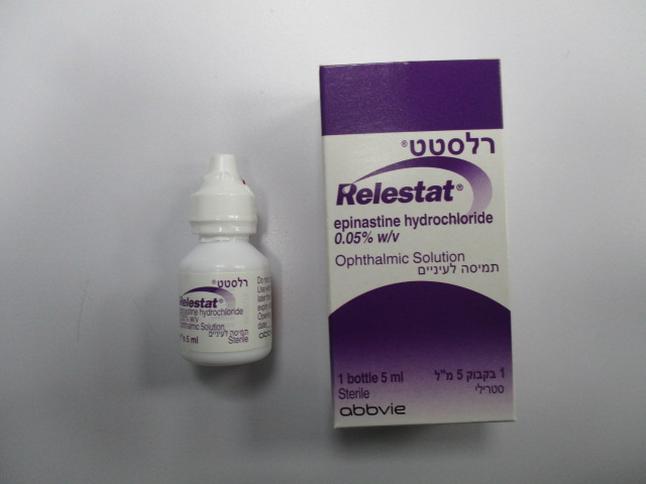Quest for the right Drug

רלסטט RELESTAT (EPINASTINE HYDROCHLORIDE)
תרופה במרשם
תרופה בסל
נרקוטיקה
ציטוטוקסיקה
צורת מתן:
עיני : OCULAR
צורת מינון:
תמיסה לעין : EYE DROPS, SOLUTION
עלון לרופא
מינוניםPosology התוויות
Indications תופעות לוואי
Adverse reactions התוויות נגד
Contraindications אינטראקציות
Interactions מינון יתר
Overdose הריון/הנקה
Pregnancy & Lactation אוכלוסיות מיוחדות
Special populations תכונות פרמקולוגיות
Pharmacological properties מידע רוקחי
Pharmaceutical particulars אזהרת שימוש
Special Warning עלון לרופא
Physicians Leaflet
Posology : מינונים
4.2 Posology and method of administration Posology The recommended dose for adults is one drop instilled in each affected eye twice daily, during the symptomatic period. There is no experience in clinical studies with the use of Relestat for more than 8 weeks. Older people Relestat has not been studied in older people. Post-marketing safety data from the tablet formulation of epinastine hydrochloride (up to 20 mg once daily) indicates that there are no particular safety issues for older people compared with adult patients. As such, no dosage adjustment is considered to be necessary. Paediatric population The safety and efficacy in children ≥12 years has been established in clinical trials. Relestat may be used in adolescents (12 years of age and older) at the same dosage as in adults. The safety and efficacy of Relestat in children aged less than 3 years have not been established. No data are available. There are limited data on the safety in children aged 3-12 years described in section 5.1. Patients with hepatic impairment Relestat has not been studied in patients with hepatic impairment. Post-marketing safety data from the tablet formulation of epinastine hydrochloride (up to 20 mg once daily) indicates that the incidence of adverse reactions was higher in this group compared with adult patients without hepatic impairment. The daily dose of a 10 mg epinastine hydrochloride tablet is more than 100-fold higher than the daily dose following Relestat. In addition, the metabolism of epinastine in humans is minimal (<10%). Therefore, no dosage adjustment is considered to be necessary. Patients with renal impairment Relestat has not been studied in patients with renal impairment. Post-marketing safety data from the tablet formulation of epinastine hydrochloride (up to 20 mg once daily) indicate that there are no particular safety issues for patients with renal impairment. As such, no dosage adjustment is considered to be necessary. Method of Administration Relestat is for topical ophthalmic use only. To avoid contamination of the eye or eye drops do not allow the dropper tip to come into contact with any surface. If more than one topical ophthalmic medicinal product is being used, the different medicinal products should be administered at least 10 minutes apart.

שימוש לפי פנקס קופ''ח כללית 1994
לא צוין
תאריך הכללה מקורי בסל
לא צוין
הגבלות
לא צוין
מידע נוסף
